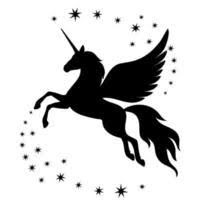Pons-Brooks Star Party
Added on 05 April 2024
held on Saturday 30th March
The last time that Comet 12P Pons-Brooks was visible, the first 'Wimpy' bar opens in London, the first British soap opera airs on TV (The Grove family), Roger Bannister breaks the four minute mile and the rationing of meat ends. That was 1954. Back in the day, Comet Pons-Brooks was conclusively discovered at Marseilles Observatory in July of 1812 by Jean-Louis Pons and later in 1883 by William Robert Brooks.
Fast forward to 30th of March 2024 and here we are having a 'star party' to view the Comet before it wanders off again into the vast reaches of the Solar System for another 71 years. This would be our last chance to see it at a reasonable hour since it was a day before daylight saving and a Saturday night. The only other thing we could ask for in this remarkable synchronicity would be a clear, calm and starry night! Yes, you guessed it! It was just such a night.
Paul, Carl and I were at the Observatory just after 5pm to arrange telescopes and cameras etc., before the official start of the party at 6pm and I have to say that the early evening was simply stunning in beauty and promise.
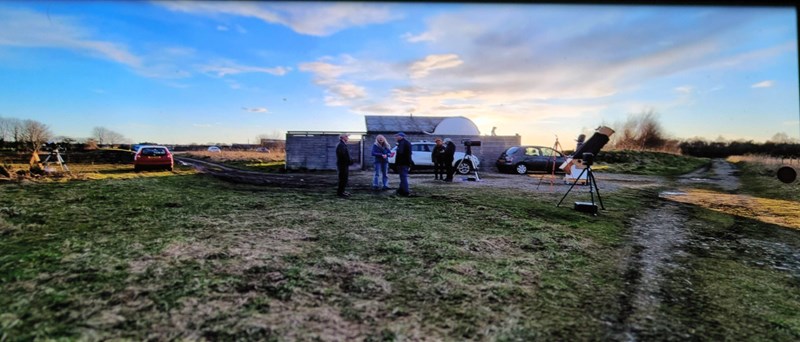
We made a cup of tea and gathered outside the Observatory compound to bask in the feeble warmth of the remaining Sunshine. Above us, a rough-legged buzzard (very rare) hovered over the adjacent field searching the ground below. Its mesmeric ability to appear motionless in the sky was what attracted our attention first and we watched in wonder as it hung there as if suspended on a wire, cannily scanning the earth for its tea. Qudos to Paul Moffett for identifying it!
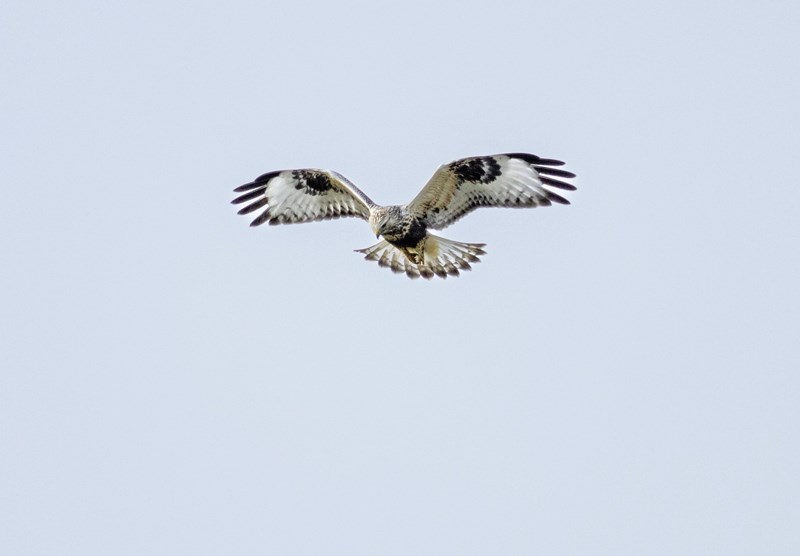
As the horizon rose up in the West to obscure the Sun and twilight fell, the sparse clouds evaporated and left the sky, revealing a canvas of deep indigo framed at the edges with intense pink and peach, all the while fading to black as the night drew closer. We had 7 telescopes of varying sizes ranging from 4 inches, all the way up to 14 inches, though sadly, the 14inch was in the dome and the Comet was obscured by the roof of the building. In addition to the telescopes, we had 4 cameras, a tracking unit and a 'SeeStar S50'. A cunning device belonging to Gerry Gaitens. Small but incredibly sophisticated, this thing takes pictures and stacks them internally to create an image viewed on a smart-phone; revealing, in astonishing detail and colour, objects unseen with the naked eye and only barely visible with a conventional telescope. The future of amateur astronomy? Probably.
In no time at all there were 18 people gathered around the telescopes. Couples, families with children, visitors and Members all gazing to the West where the Comet hung in the sky near to the star Hammal in the constellation of Aries. The green, glowing nucleus of the Comet shining bright in the eyepieces and even a hint of the tail if viewed with what's known as 'averted vision'. This technique is where instead of looking directly at the object, you cast your gaze to the side, allowing the more sensitive part of your eye to react to the light giving you a brighter and clearer image.
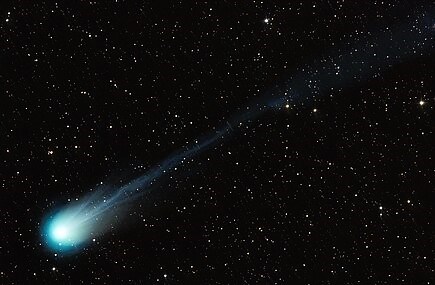
Quite a number of people were surprised to find that the Comet appeared to be stationary in the sky. They were expecting, I think, to see something flying across the heavens like you see in the movies and only when it was explained that the Comet was in fact at a distance of 125 million miles and not grazing the atmosphere was its lack of movement understood. Only then too was it apparent that this stellar visitor was of immense size! I for one was grateful that it was so far away, for if we encountered this thing at close range we may not see another dawn; just ask any dinosaur! Even in more 'recent' times, comets were viewed with suspicion and fear. Here is an extract from the Anglo-Saxon Chronicle in the tenth century. Edgar of Wessex became King of England in 959 and maintained peace throughout the land. In 975 a comet announced the death of King Edgar and the arrival of a famine.
“ Then too was seen, high in the heavens, the star on his station, that far and wide wise men call – (lovers of truth and heav'nly lore) – ‘cometa’ by name. Widely was spread God's vengeance then throughout the land, and famine scour'd the hills. May heaven's guardian, the glory of angels, avert these ills, and give us bliss again; that bliss to all abundance yields from earth's choice fruits, throughout this happy isle. ” – The Anglo-Saxon Chronicle
We have come a long way from these ideas and from culture to culture we now look on with seeming impunity at these passing giants of the Solar System. The literal is the same but the meaning is different. From subjective to objective, we no longer 'experience' comets, they are just the spectacle of an object.
So the party continued and the Comet was not the only thing that we saw. Orion was still visible though low in the South-West now and as always the Great Nebula is an amazing thing to look at, especially if you have never seen it close-up in a big telescope. Several shooting stars too, fiery red sporadic ones!
We could not have asked for a better night to see all these things; the night stayed clear and dark the whole time we were there and though it was cold, it was not too cold, and for those that felt it most we had the warmth of the 'office' to retreat to for a heat-up and tea and a biscuit. It was so great to see so many people at the party and to see the Observatory used to such great effect. The Observatory is a fantastic resource for any town to have and this year the Astronomy Club are planning to modernise the equipment there and provide greater access to all of its Members and to the wider community too. I once said that the Observatory is not a 'museum' but I have looked again at the word 'museum' and have revised my thinking. We understand that a museum is a stuffy building full of relics but the word means 'house of the Muses'; a place where we can get inspiration and wisdom from the world of the cosmos and that seems more fitting for what we have as a facility at Culloden.
We stayed until about 10.30pm before departing. Now it was cold and a thin haze was forming in the sky. A truly wonderful night and heartwarming to see the community of star-watchers grow.
P.S. The following night (Sunday) was just as dark and clear so Lisa and I went up to the Observatory so she could try and get a photo of the Comet, and here is what she managed to do! ............ Amazing.
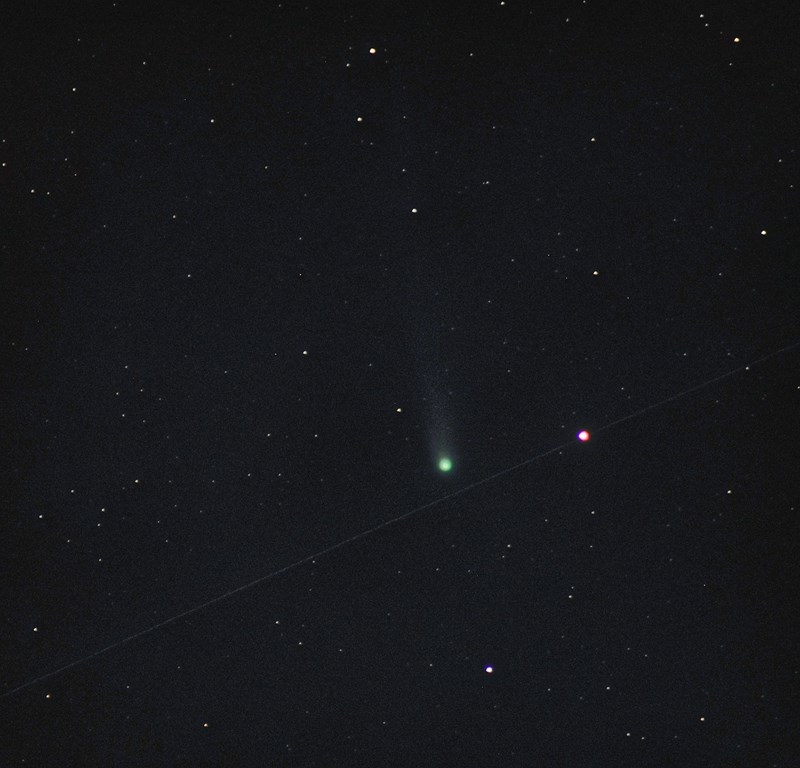
Now that the days are longer and viewing the stars becomes the realm of the 'night owls' our attention turns to the Sun and the Moon. We are approaching the time of solar maximum and sunspots and flares are to be seen on our nearest star so we will be holding 'Sun-parties' soon, with a chance to see these things with our solar telescope (recently refurbished) so look out for alerts on our WhatsApp, Facebook and Website for details.
